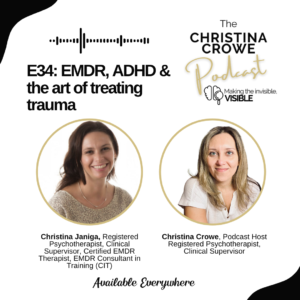Christina Janiga Psychotherapy - Blog
This blog is not a substitute for therapy, but provides evidence-based education for the purpose of self-help and information.
EMDR, ADHD & the Art of Treating Trauma
As a certified EMDR therapist and CIT, Christina Janiga was asked to be a guest on the Christina Crowe podcast: Making the Invisible Visible.
Christina Crowe is a registered psychotherapist, ADHD specialist and runs a group practice; Dig A Little Deeper in Caledon and across Ontario (and expanding into other provinces).

In the podcast, we discuss the following:
- What exactly is EMDR therapy?
- What really happens in an EMDR session?
- How EMDR can deal with and heal nightmares or recurrent dreams?
- When is dissociation ‘adaptive’ and how do you know you dissociate?
- How we can get creative with EMDR for neurodivergent brains.
What exactly is EMDR?
We give a brief history of how Eye Movement Desensitization and Reprocessing (EMDR) was developed. We also wrote a blog earlier this year explaining what EMDR therapy is, how trauma affects the brain and how EMDR helps the brain. You can learn more about this in the blog post called:
What really happens in an EMDR session?
Eye Movement Desensitization and Reprocessing (EMDR) is a type of therapy that helps people process and heal from traumatic experiences. It is based on the principles of adaptive information processing (AIP) and utilizes a series of eye movements or other bilateral stimulation (such as tapping or audio tones) to help the brain process and integrate memories related to trauma.
EMDR therapy consists of 8 phases, which are designed to help the person prepare for treatment, process and integrate their memories, and consolidate the gains made in therapy.
Adaptive Information Processing (AIP)
Adaptive information processing (AIP) is a theory that explains how the brain processes and stores information, particularly in relation to trauma and other emotionally charged experiences. According to AIP, the brain has an innate ability to process and integrate information in a healthy way. However, when a person experiences trauma or other emotionally charged experiences, their brain may struggle to process and integrate the information in a healthy way.
When the brain is unable to process and integrate information in a healthy way, the memories related to the experience can become “stuck” and the person may continue to experience symptoms such as flashbacks, anxiety, or nightmares, and difficulty sleeping. These symptoms can have a negative impact on the person’s mental and physical health as well as their overall well-being.
EMDR therapy, or Eye Movement Desensitization and Reprocessing, is a type of therapy that is based on the principles of AIP. It helps people to process and integrate the memories related to their trauma or other emotionally charged experiences by using a series of eye movements or other bilateral stimulation (such as tapping or audio tones). This then helps the brain to process and integrate the memories in a way that allows the person to move forward and find relief from their symptoms.
What is Bilateral Stimulation (BLS) or Dual Attention Stimulus (DAS)?
Bilateral stimulation (BLS) or also known as dual attention stimulus (DAS) is a technique that is used in EMDR therapy, or Eye Movement Desensitization and Reprocessing. BLS refers to the use of alternating stimulation of the left and right sides of the brain, which is believed to help the brain process and integrate memories related to trauma.
BLS can be achieved through a variety of methods, including eye movements, tapping, or audio tones (or listen to the podcast for alternative/creative ways to implement BLS into a therapy session – we even discuss sports and every day activities, ie. slinky). BLS is believed to work by activating both hemispheres of the brain and helping to “unstick” traumatic memories that may be causing symptoms such as flashbacks, anxiety, nightmares, or difficulty sleeping. By activating the neural pathways (both left and right hemispheres) that are involved in the processing of information, it is believed that they work together to process, release emotional distress, and integrate adaptive memories related to the traumatic experience.
While there is still much that is not known about exactly how BLS works in the brain, research has shown that BLS can help a person find relief from their symptoms and lead a more fulfilling life.
The 8 phases of EMDR
Phase 1:
History and treatment planning: In this phase, the therapist will gather information about your history, current symptoms, adaptive and maladaptive coping strategies, and together with you will develop a treatment plan that is tailored to your goals and needs.
Phase 2:
Preparation: In this phase, the therapist provide education on EMDR therapy, the adaptive information processing theory (AIP), expands on your adaptive coping strategies and will teach you additional coping skills that you can use to manage your emotions and thoughts before, during, and after treatment. The therapist will also work together with you to find an appropriate BLS that works for you. They will also implement neurodiverse-affirming care when finding the optimal BLS or series of BLS.
Phase 3:
Assessment: In this phase, the therapist will help you identify a specific traumatic memory or event that you would like to work on in therapy. In this assessment you will identify the images (or other sensory stressors), the negative beliefs you want to change and integrate, along with the body sensations that are attached to the traumatic memory.
Phase 4:
Desensitization: In this phase, the therapist will guide the person through a series of bilateral stimulation (the ones you identified in phase 2) while the person thinks about their traumatic memory or event. This helps desensitize aspects of the memory including the cognitive parts (images/sensations), emotions, and body sensations.
Phase 5:
Installation: In this phase, the therapist will help you to strengthen the positive beliefs and emotions that you have identified as being helpful in coping with your traumatic memories.
Phase 6:
Body scan: In this phase, the therapist will help you to increase your awareness of any physical sensations (or residual sensations) that may be related to your traumatic memories and then further relax and release the body’s residual responses and tension to the traumatic memories.
Phase 7:
Closure: In this phase, the therapist will help you to return to a state of emotional stability and provide you with coping skills (that were either developed in phase 2 or additional skills installed) to use if you experience any distress after the session.
Phase 8:
Reevaluation: In this phase, the therapist will assess your progress and determine whether additional work is needed on the traumatic memory or event.
If you are someone who is considering EMDR therapy and are interested in learning more about the 8 phases of treatment, it is important to find an EMDRIA trained and compassionate therapist who can help you navigate the process. Remember, healing is a journey and it is never too late to seek help and find relief from your symptoms.
Our EMDR Therapists

Registered Psychotherapist
Certified EMDR Therapist, CIT

Secure Services
Christina Janiga and associated employees of Christina Janiga Psychotherapy offer virtual psychotherapy and couselling sessions through secure, Canada-based software called OnCall Health and JaneVideo. OnCall Health and JaneVideo are secure and encrypted online video platforms that meet all of Canada’s privacy requirements and laws.
For more information, please see the privacy policies of OnCall Health and Jane.
